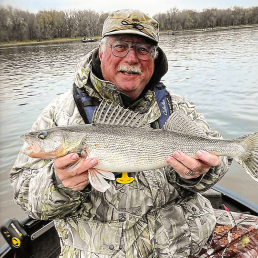Modified Wolf River Rig
SHARE THIS POST
We saw a large silver shadow in the water, and I anticipated it was going to be a big walleye. Once I got the fish to the surface, and my friend Doug extended the net as I led the fish into it, we saw that it was a huge sauger.
Once I got the fish out of the net, we quickly measured it before releasing it. It was 22 1/2 inches—the biggest sauger I ever caught.
This personal best sauger was caught on a jig and minnow—but no simple jig and minnow. The jig was a part of three-way rig I had been using for several years while fishing the Mississippi River. This rig is essentially a modified Wolf River Rig.
The Wolf River Rig has been around since the early 1940s, and as the name implies, was developed for fishing the Wolf River. In spring, when the walleyes are running, the river current can be strong, making it tough to get your bait to the bottom. The Wolf River Rig was ingenious. It started with a three-way swivel and a foot-long leader to a bell-shaped sinker, with another two-foot-long leader to a baited hook. The sinker took the rig to the bottom of the river regardless of how fast the current was and the rig kept the bait just off the bottom.
I grew up in eastern Wisconsin, and from early on fished with a Wolf River Rig.
My grandfather, who taught me how to fish, used the Wolf River Rig exclusively. He was a bait fisherman, especially with minnows. We used it when we fished the Fox River that came through the city of Oshkosh, first in early spring for the walleye run, and then usually about six weeks later for white bass.
During summer, when he and I fished Lake Winnebago for walleyes, white bass and perch, we continued to use the Wolf River Rig with minnows. From spring through summer, we caught a lot of fish on it.
Wolf River Rigs were found all along the Wolf and Fox rivers as well as Lake Winnebago in those years. Every bait shop had cards of them on the wall, as did some gas stations and even bars. They weren’t expensive, and there certainly was no shortage of them. I still have several Wolf River Rigs from those days, floating around in one of my tackle boxes.
I found the same conditions with strong currents in spring and fall on the Mississippi River when I started to fish there some 25 years ago. Initially, I used just a heavy, 3/4- or 1-ounce jig on the Mississippi. Eventually, I got to thinking about the Wolf River Rig I fished years ago, and I wondered what would happen if I replaced the bell-shaped sinker with a 1-ounce jig.
Are you enjoying this post?
You can be among the first to get the latest info on where to go, what to use and how to use it!
I found that it worked wonderfully and even increased my chances of catching fish with two hooks. My rigs use the basics of a Wolf River Rig. The one leader with the jig is 12 to 15 inches. The other leader with the hook is 18 to 24 inches.
I normally use 1-ounce chartreuse jigs, although some years when the current is not as strong, I might get away with 1/2- to 3/4-ounce jigs. One of the other modifications I have made to the original Wolf River Rig is on the hook leader: I add three chartreuse beads along with a chartreuse hook. Chartreuse is the color of choice for the beads, hooks and jigs since it stands out better in the murky water found in many rivers.
Interestingly, on some days, the jig will catch more fish than the hook and beads, and other days it is the opposite. Often, the hook and the jigs work equally well, providing two different means of catching fish at the same time. Occasionally, I have taken two fish at the same time. That makes for an exciting catch.
It was late afternoon, and I felt a hard hit. Setting the hook, the fish ran off, hugging the bottom. It took a couple moments before I got the fish off the bottom and coming toward the boat. Doug was standing by with the net and eased the net out as I pulled the fish into it. The fish was a 19-inch walleye, which was caught on the hook with beads. We ended the day catching and releasing almost two dozen fish, mostly big sauger.
The modified Wolf River Rig makes a difference and gives early-spring and late-fall walleye and sauger fishermen two productive presentations.
Author’s Note: The modified version of the Wolf River Rig with two hooks may not be legal everywhere. It is allowed for use in Wisconsin rivers such as the Wolf, Fox and Wisconsin River as well as the Mississippi River. However, in Minnesota, the modified Wolf River Rig would not be allowed due to the second hook. Check your state fishing regulations if there are any concerns.
Looking for some new fishing techniques to try this season? You’ll find plenty of suggestions in every issue of MidWest Outdoors. Subscribe on our website.
MWO
SHARE THIS POST
You may also like...
Nothing found.
Did you enjoy this post?
You can be among the first to get the latest info on where to go, what to use and how to use it!
Mike Yurk
Mike Yurk grew up in Oshkosh, Wis., where he first started writing about the outdoors. A retired Army officer, he is now a full-time, freelance outdoor writer. He has written more than 1000 articles for outdoor publications and published 12 books on outdoor sports. He lives in northwestern Wisconsin where he has found some of the best bass fishing in the country.
